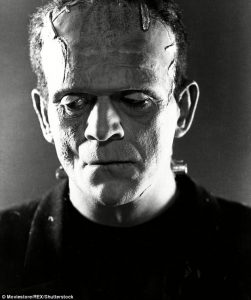"Look! It's moving. It's alive. It's alive... It's alive, it's moving, it's alive, it's alive, it's alive, it's alive, IT'S ALIVE!" - Victor Frankenstein in Universal Pictures Frankenstein (1931)
Frankenstein’s creature has many differences from other popular monsters associated with Halloween. Rather than being based off an ancient legend, a religious concept, or a historical figure, his origin is solely literary in nature, being confined to one book, Frankenstein, or The Modern Prometheus. Despite this, public perception of the creature has changed greatly since the publication of the original novel, leading to wildly divergent styles and plotlines in its various film adaptations. An understanding of literary history is necessary to understand the truth of the creature’s tragic history and how decades of film adaptations changed him into the movie monster he is today.
The Genesis of the Creature
In May 1816 Mary Wollstonecraft Shelley, her husband poet Percy Shelley, their young son, and close friend Claire Clairmont traveled to Lake Geneva. They planned to spend the summer with the scandalous and eccentric poet, Lord Byron. In the evenings, the Mary, Percy, and Lord Byron would share old German ghost stories to entertain one another. One night, Byron proposed writing their own ghost stories. A discussion of the principle of life lit a spark in Mary, in particular. She encountered a "waking dream," or night terror, in which a corpse was reanimated.
She quotes in her 1831 edition of Frankenstein: "I saw the pale student of unhallowed arts kneeling beside the thing he had put together. I saw the hideous phantasm of a man stretched out, and then, on the working of some powerful engine, show signs of life, and stir with an uneasy, half vital motion. Frightful must it be; for supremely frightful would be the effect of any human endeavor to mock the stupendous mechanism of the Creator of the world." Thus, she began writing what she thought would be just a short story.
Frankenstein or the Modern Prometheus was published anonymously in London in 1818. Mary's name first appeared in the novel when it was reprinted in 1831. Heavily influenced by the Gothic and Romantic literary movements of the 19th century, the original Frankenstein novel is different thematically from later versions of the story. The characterization of the creature himself constitutes one of the main differences. Rather than nonspeaking, the original creature's characterization is that of a sensitive, intelligent being who becomes bitter and vindictive, then murderous. Instead of killing simply because he was evil, Mary's version of the Creature performs his acts as a vengeance against Dr. Frankenstein for not creating a companion for him. Frankenstein is considered one of the first true science fiction novels and one of the earliest critiques of both the doctrine of scientific progress and 19th-century attitudes to parenthood.
Changes to the original narrative date back to the very dawn of cinema. The creation sequence began to become more elaborate as early as 1910 when the Edison Company created the first film version of Frankenstein. Like most motion pictures of the time, the film was very short, so the filmmakers chose to emphasize the spectacle of the creature’s reanimation over the novel’s elaborate characterizations. The production was one of the first successful horror films of the decade.
Karloff and the Universal Studio Classics: Frankenstein & Bride of Frankenstein
IN 1931, Universal Studios released the movie version of Frankenstein. It starred Boris Karloff as the creature and Colin Clive as Doctor Frankenstein. It involves hunchbacked assistants, elaborate laboratories in castles, and a creature who is a silent killing machine. The film inspired a sequel, The Bride of Frankenstein (1935) which not only equaled but surpassed the first film in quality. The Bride of Frankenstein is actually much closer to the original novel than the earlier Frankenstein film. Considered by many to be the best of all the Universal classic horror films, The Bride of Frankenstein is perhaps best remembered today for the creature’s somber final line, “We belong dead.”
In May 2017, Universal announced that Bride of Frankenstein will be the next classic monster reboot--the first one being The Mummy (2017). Bill Condon, director of Disney's Beauty and the Beast, is running the project and was projected to be released on February 14th, 2019. However, Universal Pictures has since pulled the movie while Bill Condon continues to work on the script.
“Not Recommended for People of Nervous Disposition”
The Hammer Frankenstein series ran from 1957 to 1974 and began with The Curse of Frankenstein. It established many of the characteristics that would distinguish Hammer’s filmmaking style: excellent set design to conceal a low budget, solid performances by Peter Cushing and Christopher Lee, color cinematography, and an extreme level of violence for the time period. The film was a huge financial success for Hammer studios and resulted in the creation of six sequels.
Perhaps the most popular modern version of the Frankenstein story is Mel Brooks’ Young Frankenstein (1974). It stars an excellent cast highlighted by Gene Wilder as the Doctor’s descendant and Peter Boyle as the Creature. The film also authentically replicates the feel of Universal's Frankenstein series down to the black & white cinematography and set design, which used many of the props from the Universal films. In the last few years, a number of attempts at creating different visionary movies involving the story of Frankenstein have emerged such as I, Frankenstein (2014), Victor Frankenstein (2015) and popular television series such as The Munsters and Penny Dreadful.
Updated by Meg Slingerland 10/2021



